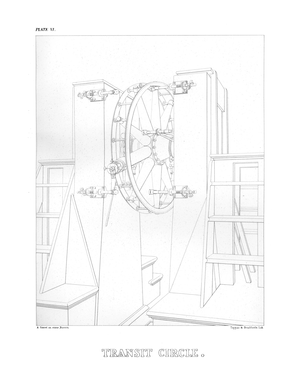
Earliest source: William Cranch Bond. "Description of the Observatory at Cambridge." Memoirs of the American Academy of Arts and Sciences vol. 4. Metcalf and Company, 1849.academybond
This is a drawing of the Observatory's best transit circle. It's a telescope, but it's mounted such that it can only rotate on a single axis. Most of these instruments were oriented along the meridian, and in that case were also called meridian circles. Meridian circles are used to precisely measure the timing of stars as they transit the meridian.
The Observatory possessed at least two meridian circles, as well as two "prime vertical" telescopes, which are transit circles oriented perpendicular to the meridian, rater than parallel to it.
This transit circle was mounted on one of the permanent piers built for that purpose, shown in other diagrams. It consists of a 4.5 inch refractor, made by Merz (same as the Great Rerfractor). This is mounted on a wheel four feet in diameter, consisting of a cast metal circle on each side, preciesly marked off around the perimeter in five minute increments. Eight "microscopes" mounted on the pier are used to read these markings, and a micrometer (in the eyepiece? or in the microscopes?) is used to accurately determine the direction of the telescope down to one arc-second, and estimate down to one fifth arc-second.
As early as 1844, the Observatory experimented with comparing remote transit times using telegraph connections to other observatories to determine longitudinal difference between locations. Telegraphs (which we now call the Victorian Internet) were a critical part of astronomical studies of that era. The Observatory had at least four permanent telegraph lines by 1887, and six by 1898.
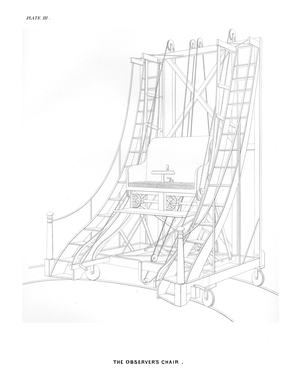
Earliest source: William Cranch Bond. "Description of the Observatory at Cambridge." Memoirs of the American Academy of Arts and Sciences vol. 4. Metcalf and Company, 1849.academybond
The observing chair for the Great Refractor. This chair was on wheels that set on a pair of circular tracks surrounding the refractor. The observer could use a rope and pully system to move the chair around the track. A crank in front of him was used to raise and lower the position of the seat.
This article, as well as Annals volume 1, includes additional drawings of the mechanical components of the chair that have not been included in this image database at this time.
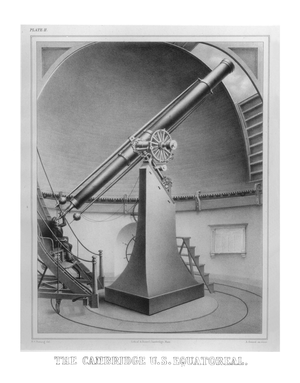
Image Credit: B.F. Nutting, A. Sonrel
Earliest source: William Cranch Bond. "Description of the Observatory at Cambridge." Memoirs of the American Academy of Arts and Sciences vol. 4. Metcalf and Company, 1849.academybond
An impressive lithograph of the Great Refractor (called the Grand Refractor in some early documents, and in this case, "The Cambridge U.S. Equatoreal" [sic]. The image linked here is HUGE and detailed, and suitable for significant cropping or zooming.
One thing that seems to be missing from this image is a finder telescope. The current finder telescope may be a telescope that used to be mounted in a dome on the west wing of the original observatory. According to "Annals" volume 8, the west wing equatorial was mounted onto the east equatorial in 1868, and I assume this is the same telescope mounted there today. It's unclear if there was originally a smaller finder, but if you look closely at this lithograph, there is something that could be a small finder telescope just above the eyepiece shaft of the main telescope.
The image is credited at the bottom to both B. F. Nutting and A. Sonrel. Nutting was a well-known Boston artist, and Sonrel was a well-known artist, lithographer, and photographer. The image is credited this way:
B. F. Nutting del. Lith of A. Sonrel, Cambridge, Mass. A. Sonrel on stone.
In practice, I'm not sure what this means. "del." is an abbreviation of delineavit, which is latin for (more or less) "drew this". But lithography was a process of drawing directly on stone (followed by several chemical treatments which caused ink to bind only where the artist had drawn). I'm not aware of any method for transferring an image from paper to stone. Nutting had done some of his own lithographs, but if he had done all the drawing, would Sonrel really be credited just for carrying out the chemical processing or printing reproduction? This seems unlikely. Either Nutting started it directly on the stone and Sonrel completed it, or Nutting drew a paper version, which Sonrel completely reproduced by hand on the stone. To me the crediting suggests the latter.
This image was copied repeatedly by other artists to make engravings and etchings of the telescope for various other publications.
The plaque on the wall is a list of donors that is still in place today, in the same position with respect to the pier. The sky is depicted as daytime and cloudy, so what the heck is the observer looking at?

Earliest source: Isaac Smith Homans. Sketches of Boston, past and present / and of some few places in its vicinity. Phillips, Sampson, and Company, 1851.sketches
An etching (or engraving, I'm no expert) based on the Nutting/Sonrel lithograph above (or both images were based on an additional unkown source).
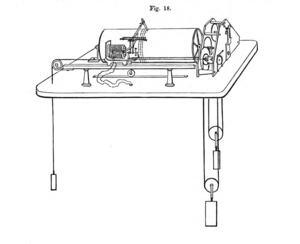
Image Credit: Electro-recording Apparatus
Earliest source: William Cranch Bond. Annals of the Astronomical Observatory of Harvard College / History and Description of the Astronomical Observatory of Harvard College vol. 1. Metcalf and Company, 1856.annals1
"Electro-recording apparatus"
As described in the annals, this device uses "electro-magnetism" and "galvanic current". It is electrically wired to the observatory clock, and to switches placed at all of the major instruemnts. It records clock ticks in spirals on a paper cylinder, which is pulley driven. It also records signals from any of the instruments. So for example, when a transit is being measured, the precise instant a star transits the meridian, the observer will press a switch which will record an event on the cylinder.
Here's my understanding at this time. The precise timing of star transits on the meridian circle is used to determine the star's exact position at the meridan, and hence in the sky. The prime vertical (transit circle) instrument can then be used to measure the exact time a star crosses the prime vertical circle (the vertical circle which is perpendicular to the meridian circle). Based on the star's known position, and this time, the observatory was able to make precise measurements of its latitude, which by 1856 was 42° 22' 48.1", which at the time was the most accurately measured latitude on Earth.
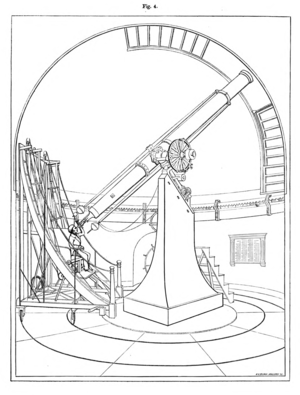
Earliest source: William Cranch Bond. Annals of the Astronomical Observatory of Harvard College / History and Description of the Astronomical Observatory of Harvard College vol. 1. Metcalf and Company, 1856.annals1
Another drawing based on the Nutting/Sonrel lithograph.
Inscribed at the bottom with "Kilburn-Mallory SC". SC is short for sculpsit, latin for "carved this" (because this is an engraving).
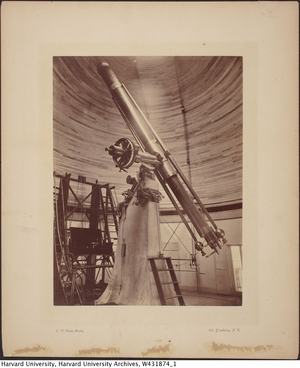
Image Credit: G. W. Pach
Earliest photo found so far of the Great Refractor.
Taken by G. W. Pach, of Pach Brothers photography, a well known photography firm for over a century. Their work includes Presidents and other famous people of their day like Samuel Clemens. They went into business shortly after the Civil War, by 1867. (Although another source says 1872.) Their address is printed on the image, and shows 841 Broadway, N.Y. The Pach brothers moved from this address to 935 Broadway somewhere in the range of 1888 to 1890. After which their building burned down and the lost their collection of negatives. I don't know if they reopened in New York, but the continued on in other cities.
I thought the data was further nailed down by the fact that there is no finder scope visible. In 1868, the observatory took the smaller refractor off of their west equatorial mount, and attached it as a finder telescope, to the side of the Great Refractor. However on further examination, I think that telescope is mounted, almost entirely hidden on the far side of the telescope. So now I'm much less sure of the date. [Possible that they were at 858 Broadway before about 1878 or '79]
The wood surface inside the dome is now painted white, which is too bad, because this looks amazing.

Image Credit: Thomas A. Fine
Construction of the dome to contain the 28-inch reflector donated by Mrs. Draper for the Draper Memorial project.
Eleven photos processed into an animated gif.
Some alternate copies of these images have penciled in dates, and based on this, the construction began before July 12, 1887 (when the platform was completed), and completed after September 1 of the same year (when the building skirt was added but the dome skirt was not in place).
A copy of the sixth image in the sequence has a date written on it, which dates the middle of the construction to July 27, 1887.olvwork432353(missing) The position of the building makes it clear that this is the dome for the 28-inch reflector, which was the second of the three large additional domes that were built.
Use/Copyright: This work is licensed under a Creative Commons Attribution 4.0 International License. 
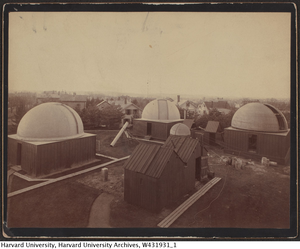
Earliest source: "[Harvard College Observatory, Cambridge, construction, ca. 1892]." Harvard University Archives / UAV 630.271 (279). Harvard Libraries, olvwork431931
Harvard gives this image a date of 1892, which is unlikely. The rightmost dome seems to have construction supplies in front of it, and if that's the case, this dates the image to late 1887 or early 1888, as that is when this third dome was completed for the Boyden Fund.annual1887 I also need to determine when the uncovered 15" reflector was removed and replaced with an odd shed that may be a "meridian photometer" shown in later images. The first two domes were completed in 1886annual1886 and 1887.annual1887 It can't be any later than 1892, because another photo which is prior to the construction of the brick building shows the platform already in place.
This is an unusual angle, reverse of a great many photographs. Just to the left of the dome in the center, is a house which was connected to the observatory—literally. Telegraph lines ran there. This house is the house from which a large number of later pictures were taken. Shown in more detail in a later photo (which also shows the addition of an observing platform that did not exist here).
I have no idea what those two wooden buildings in the foreground housed. But they were removed sometime between the new brick building (1892), and the brick addition (1902). Also, the building on the left was previously longer, and in this photo appears to be very recently shortened.

Earliest source: Edward C. Pickering. "The Astronomical Observatory." Harvard Alumni Bulletin vol. 17 no. 23. Harvard Bulletin, Inc. Boston, Mass., 10 March 1915.alumni1915
This article was published in 1915, but is clearly an older photo of the observatory. It is almost identical to an image above, except that image shows three intsruments open which are all closed here. Other than that they appear identical. (exact same angle, same instruments, awning on the original building, pipe on the roof of original building, domes facing the same directions, even the slightly open curtains in builing C appear the same).
This image is also found in "The Henry Draper Memorial" by Annie J. Cannon from The Journal of the Royal Astronomical Society of Canada, v. 9. 1915.
The image found there identifies many of the instruments:
 Fine's Home
Fine's Home